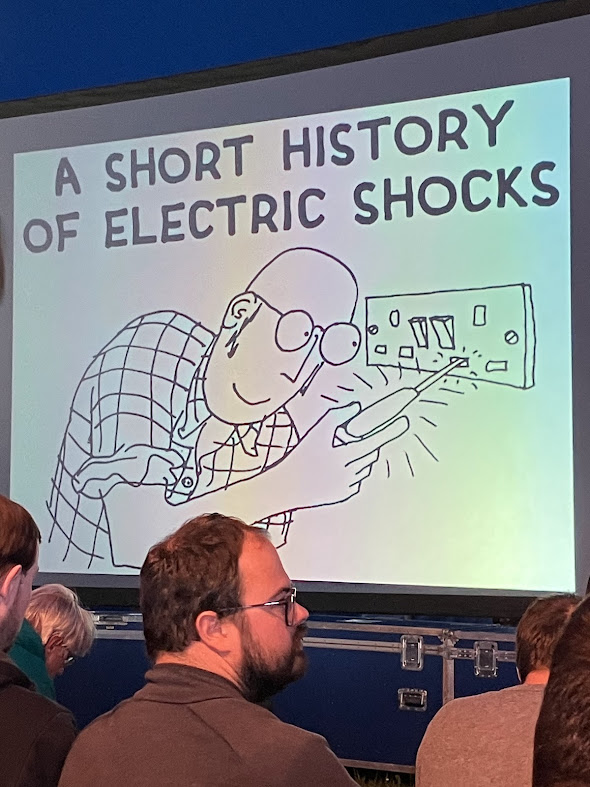My EMF 2024 Highlights
My Electromagnetic Field 2024 highlights, in rough chronological order:
- On Thursday I volunteered as an entrance steward, and in the bar. I’ve never worked in a bar before, and it was hard but exhilarating work as there’s lots to learn (pulling pints, and the till system).
- Someone had converted a Henry hoover into a radio-controlled robot.
- In the intro talk, Jonty said that 43 festivals have been cancelled this year. Also EMF had three times as many talk proposals as last time, and they’re not sure why. And EMF Camp is staying put - they now have a 40Gb/s wired connection to the festival site!
- PINECIL soldering irons look nice. (From Drew Batchelor’s “The Tiny Tool Kit Manifesto” talk, see https://tinytoolk.it/.)
- I went to Matthew Macdonald-Wallace’s talk about building a rural makerspace, and learned that he set up Make Monmouth which is only a 40-minute drive from me.
- Tim Jacobs talked about four iterations of his digital clock in “GPS time, leap seconds, and a clock that’s always right”. DST is a horror at the best of times, but if you want your clock to work everywhere then it’s another level.
- Iain Sharp has built a lovely mechanical version of the arcade classic, Lunar Lander, which he talked about in the EMF Arcade. It was nice to see Tim Hunkin there in the audience, as it’s now at Southwold Pier which hosts many of Tim’s creations. Iain’s new flappy bird game was in the bar, attracting a lot of attention. (I was also pleasantly surprised to learn that Ian is the creator of CircuitJS, which I used for my 8-bit computer simulation last year.)
-
Maker hero Tim Hunkin gave a wonderful talk, “A Short History of Electric Shocks”, which was full of arresting images and gentle humour. My only regret was that I forgot to bring my copy of “Almost Everything There is to Know” for him to sign.

- For lasers, Seb Lee-Delisle is the man. His talk also included a flappy bird game, projected on the tent wall using lasers. As if that wasn’t enough, later on he projected a playable asteroids game onto the hillside!
- At the Maths Jam, Matthew Scroggs gave a lightning talk about the maths behind “Big Ben Strikes Again”, an episode of Captain Scarlet and the Mysterons when Big Ben strikes 13. It’s all in this blog post, including a video reproducing the phenomenon.
- A 5km run around the deer park.
- George Cave kicked off the Saturday talks with “Connecting Arduinos to websites: A sequence of chaotic live demos” - he did both parts of the title with aplomb. New things for me:
chrome://device-log/, stretch sensors, WebUSB, Adafruit ItsyBitsy, more here. - My favourite talk was Skylar MacDonald’s “How to Save a Life” - about what happens when you dial 999. Fascinating subject; flawless fast-paced delivery; packed with technical nuggets.
- Michael Arntzenius wrote FizzBuzz in Emacs using his voice in his “Writing computer code by voice” talk. Mesmerising - it’s definitely worth a watch when the videos are made available! The key tech is Talon and Cursorless (for VSCode).
- Richard Wiseman suffered AV issues while the audience waited - sadly, they couldn’t be fixed - but he gave a delightful magic show without any slides in “Magic Your Mind Happy”.
- I got a ticket to Joe Nash’s workshop “Eavesdropping on Eastnor’s bats: an introduction to bioacoustics in the field”. The bonus was that, after learning the theory, we got to build a π•pistrelle bat detector, and then go for a bat walk at dusk. The build involved surface mount devices, which I have never used before and are tiny and difficult to place on the PCB - so it was great being in a group (led by Kliment) all working alongside each other. Thankfully my detector worked, and we saw (and heard) lots of bats near the lake. What a treat.
- Neil Monteiro’s “From Makerspace to Outer Space” was a good way to start Sunday, and this stat jumped out at me: there are 1,300 space companies in the UK.
- PINECIL came up again in doop’s “Practicalities of being a walking lightshow” talk, which packed a lot of tips about the options (glow sticks, UV reactive, electroluminescence, LEDs) into 20 minutes. Their recommendation for “beatmatching” (to music) was to ignore AI and keep it simple - do it manually with a button to set the beat based on a couple of clicks.
- Andy Piper was asked the question “Where is the Art?” when he and his partner were showing their pen plotter art at a local art exhibition. His talk deftly mixed history with practical tips ranging from the simplest pen plotter (the charming BrachioGraph) to the much more capable AxiDraw. Find resources here.
Find more information from the EMF 2024 schedule.
See my photo album